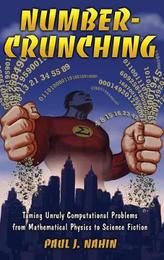
|
Number-Crunching: Taming Unruly Computational Problems from Mathematical Physics to Science Fiction
Hardback
Main Details
| Title |
Number-Crunching: Taming Unruly Computational Problems from Mathematical Physics to Science Fiction
|
| Authors and Contributors |
By (author) Paul J. Nahin
|
| Physical Properties |
| Format:Hardback | | Pages:408 | | Dimensions(mm): Height 235,Width 152 |
|
| Category/Genre | Computer programming and software development
Mathematical theory of computation |
|---|
| ISBN/Barcode |
9780691144252
|
| Classifications | Dewey:510 |
|---|
| Audience | | General | | Tertiary Education (US: College) | |
|---|
| Illustrations |
4 halftones. 98 line illus. 6 tables.
|
|
Publishing Details |
| Publisher |
Princeton University Press
|
| Imprint |
Princeton University Press
|
| Publication Date |
28 August 2011 |
| Publication Country |
United States
|
Description
How do technicians repair broken communications cables at the bottom of the ocean without actually seeing them? What's the likelihood of plucking a needle out of a haystack the size of the Earth? And is it possible to use computers to create a universal library of everything ever written or every photo ever taken? These are just some of the intriguing questions that best-selling popular math writer Paul Nahin tackles in "Number-Crunching". Through brilliant math ideas and entertaining stories, Nahin demonstrates how odd and unusual math problems can be solved by bringing together basic physics ideas and today's powerful computers. Some of the outcomes discussed are so counterintuitive they will leave readers astonished. Nahin looks at how the art of number-crunching has changed since the advent of computers, and how high-speed technology helps to solve fascinating conundrums such as the three-body, Monte Carlo, leapfrog, and gambler's ruin problems. Along the way, Nahin traverses topics that include algebra, trigonometry, geometry, calculus, number theory, differential equations, Fourier series, electronics, and computers in science fiction. He gives historical background for the problems presented, offers many examples and numerous challenges, supplies MATLAB codes for all the theories discussed, and includes detailed and complete solutions. Exploring the intimate relationship between mathematics, physics, and the tremendous power of modern computers, "Number-Crunching" will appeal to anyone interested in understanding how these three important fields join forces to solve today's thorniest puzzles.
Author Biography
Paul J. Nahin is the author of many best-selling popular math books, including "Mrs. Perkins's Electric Quilt", "Digital Dice", "Chases and Escapes", "Dr. Euler's Fabulous Formula", "When Least Is Best", and "An Imaginary Tale" (all Princeton). He is professor emeritus of electrical engineering at the University of New Hampshire.
Reviews"Great stories. Interesting and challenging problems. Instructive MATLAB code. Lots of physics. That's my in-a-nutshell assessment... Nahin takes on the subject of using computers to solve difficult problems, many in physics, that couldn't be solved before computers... This is one of those books that one can read as a spectator, enjoying the scenery, taking in the landscape, appreciating the rich stories--my relationship with the book--or one can dive in, study the many equations, run the code, and have a personal experience of how problems that were unsolvable just a few decades ago have succumbed to computers."--Sol Lederman, Wild About Math "Number Crunching is most timely, given the escalating scale of economic, commercial, and financial transactions, necessitating thinking about, evaluating, and communicating on a much larger scale... The presentation in Number Crunching is simultaneously accessible, readable, entertaining, daunting, sophisticated, and technical."--Stephen E. Roulac, New York Journal of Books "Number-Crunching is packed with copious notes and references and augmented by significant challenge problems that take the reader beyond the text and which would make good undergraduate projects... Nahin's aim is clearly to convey enthusiasm for the subject to a younger reader and to give a glimpse of what is technically possible... He looks to convey the excitement that he and many of us had when first attracted to the physical sciences as we were growing up--the excitement at the realisation that, given a few tools, even an awkward teenager can make quantitative statements about the world."--C.J. Howls, Times Higher Education "Paul Nahin, a prolific and knowledgeable expository writer, is a professor emeritus of electrical engineering at the University of New Hampshire. What he offers in Number-Crunching might be described as a mix of (1) supplementary readings for courses in mathematics, physics, or electrical engineering, (2) 'challenge problems' intended as a brain-jogging call to prospective professionals, and (3) a garage sale of mathematical miscellania and esoterica."--Philip J. Davis, SIAM News "[Number-Crunching] is impressive for several reasons. First, Nahin has found the right level--not too easy and not too hard. Second, the problem selections and topics are interesting and in several cases give surprising results. Finally, the book is just plain fun."--Choice "[A] highly entertaining and rewarding read."--Dean Rickles, Mathematical Reviews "Unlike writers of popular mathematics books, Nahin is more then happy to spray the pages with equations! Since these are surrounded by lucid and informal explanations, they add significant value to the book... Whether or not you are the computing type, there is a lot to enjoy about this book."--Alan Stevens, Mathematics TODAY "Many of these challenge problems would make excellent projects--both in mathematics or physics--for undergraduates to explore. Number-Crunching's greatest strength is providing a perspective on how three unique yet vastly intertwined fields interact while keeping readers more and more intrigued as they progress through the text. Readers will find abundant resources to quench their thirst for knowledge of computational mathematics and physics."--Brandon Milanovich, Mathematics Teacher
|